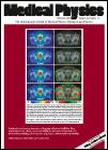版权所有:内蒙古大学图书馆 技术提供:维普资讯• 智图
内蒙古自治区呼和浩特市赛罕区大学西街235号 邮编: 010021

作者机构:Univ British Columbia Dept Phys & Astron Vancouver BC V5Z 1M9 Canada Univ British Columbia Dept Radiol Vancouver BC Canada
出 版 物:《MEDICAL PHYSICS》 (医疗物理学)
年 卷 期:2012年第39卷第3期
页 面:1374-1385页
核心收录:
学科分类:1001[医学-基础医学(可授医学、理学学位)] 1009[医学-特种医学] 10[医学]
基 金:Natural Sciences and Engineering Research Council (NSERC) of Canada [PGSD2-392011-2010]
主 题:Medical imaging Heart Single photon emission computed tomography Photons Medical image artifacts
摘 要:Purpose: Our template-based quantitative perfusion single photon emission computed tomography (SPECT) method (T-QPS) performs semiquantitative analysis for myocardial perfusion imaging (MPI) without the use of normal databases. However, in its current form, T-QPS requires extensive calculations, which limits its clinical application. In the interest of clinical feasibility, the authors examine the trade-off between accuracy and processing time as the method is simplified. Methods: The T-QPS method uses the reconstructed SPECT image of the patient to create a 3D digital template of his/her healthy heart. This template is then projected, reconstructed, and sampled into the bulls-eye map domain. A ratio of the patient and template images produces a final corrected image in which a threshold is applied to identify perfusion defects. In principle, the template should be constructed with the heart and all extracardiac activity, and the projection step should include primary and scatter components;however, this leads to lengthy calculations. In an attempt to shorten the processing time, the authors analyzed the performance of four template (T) generation methods: TP-HRT, TPS-HRT, TP-HRTBKG, and TPS-HRTBKG, where P and S represent primary and scattered photons included in the projection step, respectively;and HRT and HRTBKG represent template constructed with the heart only and the heart with background activity, respectively. Forty-eight thorax phantoms and 21 randomly selected patient studies were analyzed using each approach. All studies used GE s Infinia Hawkeye SPECT/CT system and followed a standard cardiac acquisition protocol. Results: Approximate processing times for the TP-HRT, TPS-HRT, TP-HRTBKG, and TPS-HRTBKG methods were less than a minute, 2-3 h, less than a minute and 3-4 h, respectively. In both the simulation and patient studies, a significant reduction in the quality of perfusion defect definition was exhibited by the TP-HRT method relative to the other t